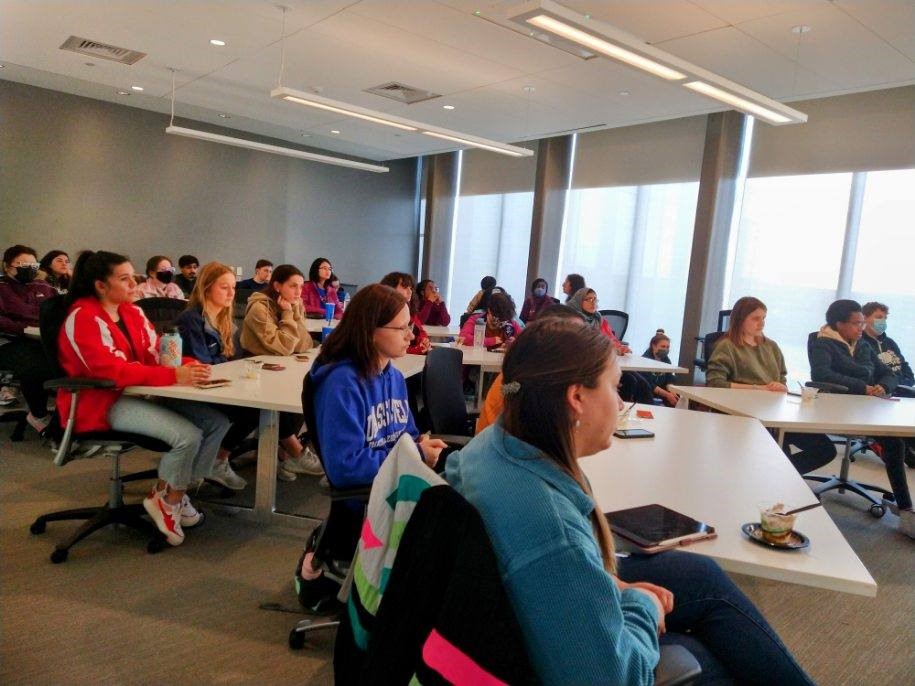By: Doa Jamal, Francis College of Engineering Well-being Leaders
This semester, I chose to do my honors project for the Honors College. At first, I was having trouble deciding on what to do. Last fall, I took the Graphic Novels in Science and Medicine course as an Honors College elective. I enjoyed the class as it was the first class that allowed me to draw, which I don’t usually do during the academic year. The only times I draw are usually during the Summer or sometimes during school vacations as a way to relax. I would say this was the class I enjoyed the most during my entire four undergraduate years. The final project was to make a mini graphic novella where the booklet told a short story. The goal was to create something meaningful to us. Almost immediately, I knew I wanted to do something related to well-being because being a well-being leader has made such a meaningful impact on me. I also know that I am not adept at drawing humans, so I chose to make my characters flowers. The flowers also go along with the idea of growth and well-being blooming.
Working on the project to create a small booklet teaching about the eight dimensions of wellness through comics was an incredibly rewarding experience. It provided me with the opportunity to combine my passion for both art and wellness education in a creative and engaging way.
The eight dimensions of wellness encompass various aspects of a person’s life, promoting holistic well-being. These dimensions include physical, emotional, social, intellectual, occupational, environmental, spiritual, and financial wellness. Each dimension addresses different facets of life, from maintaining physical health to fostering meaningful relationships, pursuing personal growth, finding purpose in work, connecting with nature, nurturing spirituality, and managing finances responsibly. Prioritizing these dimensions is crucial as they collectively contribute to a balanced and fulfilling life. Neglecting any dimension can lead to imbalances, affecting overall health and happiness. By striving to enhance each dimension, individuals can cultivate resilience, improve their quality of life, and experience a sense of fulfillment and satisfaction.
One of the most fulfilling parts of this project was the creative freedom I had in designing the comics. Being able to draw everything by hand allowed me to infuse each illustration with personality and convey complex concepts in a visually appealing manner. I found that the process of sketching, refining, and digitally editing the illustrations in Photoshop was both enjoyable and therapeutic. It allowed me to immerse myself in the project and truly bring the content to life. Although spending continuous hours in front of a screen to thoroughly Photoshop the images did almost drive me insane. Now I better understand art students.
However, creating a booklet solely through comics presented its own set of challenges. I had to strike a balance between conveying information effectively and ensuring that the comics remained engaging and easy to understand. This required careful planning and attention to detail in both the artwork and the accompanying text. I found myself constantly revising and refining each comic to ensure that it effectively communicated the key principles of the eight dimensions of wellness.
One of the most valuable lessons I learned from this project was the importance of collaboration and feedback. Throughout the process, I sought input from my mentor to ensure that the content resonated with the target audience and effectively conveyed the intended message. Incorporating feedback allowed me to refine the comics further and improve the overall quality of the booklet.
Moreover, working on this project reinforced the importance of wellness and self-care in my own life. As I delved deeper into the eight dimensions of wellness, I found myself reflecting on my own habits and practices related to physical, emotional, and mental well-being. This project served as a reminder to prioritize self-care and make conscious efforts to maintain a balanced and healthy lifestyle.
In conclusion, working on the project to create a booklet teaching about the eight dimensions of wellness through comics was a fulfilling and enriching experience. It allowed me to combine my passion for art and wellness education while learning valuable lessons about creativity, collaboration, and self-care. I am grateful for the opportunity to have worked on this project and am excited to see how it will positively impact others on their journey towards improved well-being.
